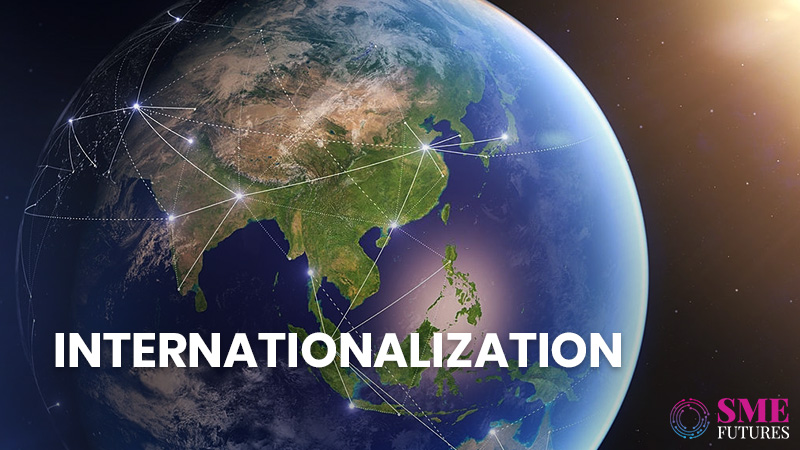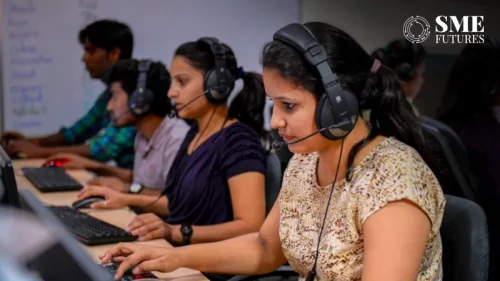Internationalization is considered the expansion of the firm’s economic activity across the country’s national borders. If you thought Internationalisation was only the act of exporting, that’s akin to saying Marketing and Sales are the same things. Exports are a part of internationalization, not the other way round.
In exportation, exchanges are made transactional. However, there are no long term guarantees. Generally, there is also a risk of it coming to an abrupt halt. In contrast, by internationalization, one employs a long term strategy concerning a new market, and it covers a wide range of activities that help it be successful. Internationalization, in simple words, means successfully moving into international markets.
SMEs are more accessible to internationalization due to the development of technology. The use of technology like social media, Artificial Intelligence, Remote Working helped the SMEs in expansion and internationalization, thus allows more integrated supply chains and quick contact with contractors, suppliers and Partners. It is estimated that post covid, 43% of SMEs have been using various technology platforms to sell and promote themselves.
Exports of Indian SMEs includes manufacturing, pharmaceuticals, healthcare, packaging, ICT, IT, Food Processing, Engineering, Textiles, Garments, Plastics, Furniture, Foundry, Capital goods and allied sectors.
The Government initiatives like Skill India, Make in India, Startup India, and Digital India have helped SMEs go Global.
The ‘Make in India’ campaign has created a lot of eyeballs for India. Countries and companies have been exploring opportunities to produce in India to take advantage of India’s enormous market and become competitive in other countries. The pandemic has further increased the opportunities.
On account of the anti–China sentiment, several countries are now considering alternative suppliers. Australia has gone on record and announced the same. Several other countries and companies are actively sourcing alternatives. South-East Asia has really benefitted from this. Even Bangladesh has reaped dividends.
Once a company is established in the local market, product/services stagnation risk sets in. A company’s growth may mean that internationalization is imperative once it crosses a particular stage.
Over the last few years, working closely with clients, we have realized that several Indian companies have incredible quality products that are limited in a local market, ahead of their time or better suited for an overseas market. Stagnation is inevitable because of the nature of the product in a limited local market, its utilization or the price point.
Assume your company is ready to dive into the international arena. It’s prudent to begin by taking stock of your current standing and planning the activity before venturing there. So start by asking:
- Where am I today?
- Where do I want to go from here?
- How will I get there?
These questions look simple. But without answering them, one cannot assess the options available to explore its full potential.
SMEs and entrepreneurs should consider internationalization for many reasons. Increasing sales, process efficiency, reducing labour or supply costs, diversifying operations, boosting production, increasing proximity to clients and stable expansion with Joint ventures.
Through our research, we’ve found two classic scenarios that are a litmus test before being ready to take the plunge:
Case 1: Market entry strategy: In the first case, the entrepreneur is aware of his product line that he would like to take to the international market. Identifying the optimal market means taking into consideration the economic, social and political scenario of that place. It would enable a long term business vision rather than a windfall gain or loss only for a couple of years.
Case 2: Diversification: In the second scenario of any diversification envisioned by the entrepreneur in a new market, it is essential to identify the attractive sectors prevailing at any point in time in a particular market and having a sustainable market.
In both cases above, identifying the best strategy to do business, i.e. whether to have only exports, have a JV or even a physical set up at such a place based on an extensive financial model developed on a case to case basis. Suppose a JV or physical set-up is advised. In that case, it is essential to know players in each sector to advise on the most appropriate partner depending on the financial parameters and consider the cultural patterns.
There are, of course, several challenges associated with internationalization. One needs to do much homework before venturing out. Some of these impediments could be – Lack of reliable data on overseas market, Lack of awareness of potential customers, Lack of knowledge about export rules, procedures and documentation etc.
Hence, an SME needs to be well informed and prepared before commencing on the path of internationalization.
Globally, options grow exponentially. Businesses are transactional, which means there is a give and there is a take. While we are looking to expand externally, opportunities also arise for growth internally.
That, of course, brings us to the question of how big these markets are and what kind of opportunities exist. Many European entrepreneurs are keen on investing in India either via technology or financial investment.
The market in most European countries is limited. Hence, they look at being more competitive in terms of pricing or look at exploring other geographies. The goal is to produce at a much lesser cost in India, explore the ever-growing Indian market, and source the product back to their home countries and other needs. Several business opportunities with Europe, particularly Southern countries like Spain and Portugal, are yet to be explored. Several entrepreneurs in these regions are desirous of joining hands with Indian entrepreneurs.
African markets: The CPLP is an international organization formed by Portuguese speaking countries that seek to deepen mutual friendship and cooperation. The CPLP represents 250 million people. Countries like Angola and Mozambique are growing very fast and are in great need of goods, technology and services due to the lack of suppliers in these regions.
The Mercosul Community in Latin America – 275 million inhabitants representing 70% of the total South America population, belong to this community. They contribute 83% of the GDP of South America. Countries like Chile, Uruguay, Paraguay and Venezuela are developing, stable and open for new businesses.
As we can see, innumerable market opportunities in each region must have a long-term strategy before entering the markets. Companies must never forget to:
- Analyse markets and opportunities in countries in relation to your existing / dream product.
- Clearly define the international strategy and business model.
- Implement locally in the new market (through a partnership with local players after obtaining complete knowledge about them)
- Research is undervalued but the lack of it can be costly for an SME. Knowledge is power.
India’s handicap is its ranking of ‘Ease of Doing Business. It still needs to be more effective at ground level. Further, investment and business-friendly policies are required to be rolled out and soon. Policies like the PLI scheme will boost internationalization. Internationalization is within reach for most companies. New frontiers are waiting to be explored, within reach, waiting with an outstretched hand to welcome companies to the other side. The time to reach out and take it is Now.











